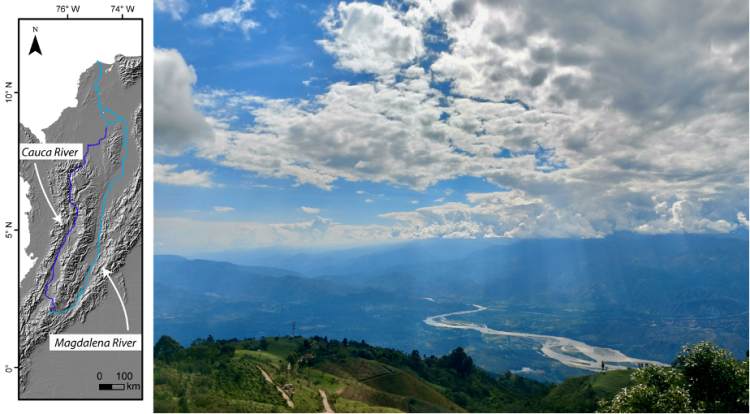Nicolás Pérez-Consuegra - Project Profile
2020 AGeS awardee
Lab: CU Thermochronology Research and Instrumentation Lab
Lab Mentors: Becky Flowers
What scientific question(s) does your research address and what motivates this work?
River canyons are among the most remarkable landforms found on earth. The formation of canyons has significant implications for the development of landscapes and the existence of life on our planet. The process of canyon formation usually involves alterations in the drainage network and the course of rivers which impacts the influx of sediment and freshwater into the oceans and affects the distribution of aquatic organisms that inhabit river networks.
Various hypotheses exist regarding the formation of canyons. Canyons can form when mountain ranges grow in elevation and the rivers behave as knives, carving through the rocks and creating gorges. Other research suggests that changes in climate may be linked to the incision of canyons. For instance, during the Miocene period approximately 15 million years ago, it is thought that heightened precipitation rates led to rapid incision in the Mekong River of China.
What about canyons situated in tropical regions? Do unique processes operate within these hot and humid areas? To investigate these questions, I have chosen to study the Tropical Andes in Colombia and analyze the vast Cauca River Canyon to understand the mechanisms involved in its formation.

Figure 1: Location of the Cauca River in the Northern Andes in Colombia
What chronometric tool did you employ and why?
For this project, a combination of techniques was employed. Firstly, satellite imagery data was utilized to analyze the landscape. Then, rock samples were collected through fieldwork conducted along one of the canyon's steep walls. Finally, the rock samples were crushed, and the mineral apatite was extracted to conduct U-Th/He thermochronology analyses at Dr. Flowers' laboratory at the University of Colorado Boulder.
Thermochronology is a technique that allows us to figure out when and how fast a canyon is carved into a mountain. A river forming a canyon is analogous to a person digging a trench with a shovel, as the person removes material it uncovers the rocks that were buried. The technique tracks the time it takes for a rock to go on a journey from deep inside the Earth’s crust to the Earth’s surface. When the rocks are buried inside the Earth’s crust, they are hot and when they approach the surface they cool down. To track the time, the technique uses the principles of radioactive decay, which works like a stopwatch that starts ticking once a rock cools through a specific range of temperatures, keeping track of the time it takes for the subsequent journey to the Earth’s surface. The mineral apatite is the radioactive stopwatch that we used in this study.

Figure 2: 3D view of the Cauca River Canyon
What were some of the key takeaways of your research?
The thermochronology results are very interesting and suggest that the studied landscape was younger than previously thought. The results show that the canyon started forming in the late Miocene and the onset of incision coincides with major changes that were occurring in the tectonic plates below the Andes of Colombia. At 6–10 Ma the plate subducting beneath the Cauca River Canyon became flat, which the authors suggest could have driven the uplift of the mountain range.
What new experiences, opportunities, and collaborations did you gain as an AGeS-Grad awardee?
As a grad awardee, I have been fortunate enough to meet professors and colleagues who are conducting fascinating research in various geochronology disciplines. Additionally, I had the chance to travel to Colorado to conduct the analyses using a new technique, allowing me to garner laboratory experience. Through these experiences, I was able to advance my doctoral research and explore research questions that were not funded by my advisor.
What is one piece of advice you have for future AGeS-Grad award applicants or awardees?
For individuals interested in applying for the grant, I recommend several key steps. Firstly, start the writing process for your research grant proposal early to allow ample time for revision and refinement. Additionally, seek insights from previous awardees to gain a better understanding of what aspects contribute to a successful proposal. Furthermore, engage in discussions with the laboratory leader beforehand to obtain their valuable feedback regarding your proposal. Creating an engaging and informative figure can also enhance the proposal's impact. Finally, be sure to review the rubric published on the AGeS webpage to better understand how proposals are evaluated.

Figure 3: Examples of how canyons can form.

